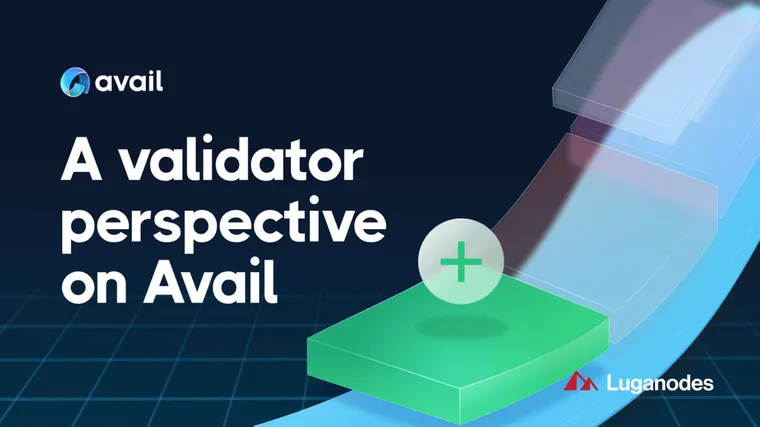The Web3 ecosystem faces multiple challenges it must overcome in order to reach global mass adoption. These challenges are primarily linked to how well the infrastructure can scale. While incredible breakthroughs in scaling blockchains have emerged, they must all cohesively unify to provide a seamless and smooth experience for end-users.
Transacting across different chains and ecosystems today is still cumbersome, and that's why Avail has been built from the ground up to solve this. Avail’s vision is to help onboard new users to Web3 as a whole rather than as fractured groups engaged in a perennial contest between opposing crypto communities.
Avail seeks to unify web3 and plans to do so utilizing advanced modular technology. Peter Thiel's Founders Fund has also backed the vision, having taken part in a $27 million seed round, contributing to $75 million in total funding.
Modularity and Data Availability
Avail takes a modular approach to blockchain design and operates as a base layer, primarily focusing on data availability. It’s designed to serve next-generation blockchain applications and sovereign rollups with an innovative security feature that enables light clients (see below) to mathematically verify data availability through sampling.
The idea for sovereign rollups has been growing in popularity as a novel blockchain design. Sovereign rollups differ from their predecessor—smart contract rollups. In the modular stack, sovereign rollups deal with the execution and settlement layers, and can benefit greatly from the extremely fast and mathematically verifiable DA guarantees offered by Avail DA.
In short, Avail seeks to anchor the Web3 ecosystem with its cutting-edge and unprecedented data availability layer. Its modular tech stack enables Rollups to adapt, stay secure, and excel in an ever-changing environment that's striving to scale. While this article is validator-centric, let's first look at parts of Avail's wider roadmap for necessary context.
Avail’s Unification Thesis
Rollups are flourishing, but they desperately need data availability blockspace. Additionally, they need to communicate in a Rollup-centric ecosystem to avoid further fragmenting the UX.
Avail's mission is to unify Web3 so that different ecosystems can prosper while remaining connected. It seeks to accelerate the unification of Web3 in three phases:
- Avail DA to scale
- Nexus for unification
- Fusion for shared security
Besides its foundational data availability layer, Avail has been developing the "Unification Layer," introducing Fusion, an additive security layer, and Nexus, the interoperability layer.
Nexus unifies Web3 by connecting multiple chains within and outside of Avail's ecosystem. It is a more structured component that upholds integration standards between Rollups. This layer is critical in crafting a seamless UX whether users are working with single or multiple Rollups within Avail, or interacting with external chains.
Avail Fusion will bring additive security to the ecosystem. It will also mark one of the first times that users can stake outside tokens like BTC and ETH alongside Avail's native assets to fuel consensus on a different blockchain.
Types of Nodes on Avail
While Avail differs from conventional monolithic blockchain frameworks, it does utilize a wide variety of node types, including Full Nodes, Light Clients, Archive Nodes, and Validator Nodes.
Full Nodes exist on Avail, but they play a supplementary role, which marks a significant departure from how monolithic blockchains operate. They are more of a backup to maintain the redundancy of network’s data. Full nodes do not store the blockchain's entire history, but they do keep the blockchain's current state. Nonetheless, most applications developed on Avail can function with just Light Clients.
The Light Client lets users interact with the Avail blockchain without running a full node. Light Clients verify validity proofs for quick queries, and Avail implements them natively with data availability sampling.
While the double spend attack is the primary attack vector on blockchains like Ethereum or Bitcoin, with Avail, the vector is data "unavailability." Thus, Avail's Light Clients address the limitations faced by traditional light clients by performing random data availability sampling. With data availability sampling, Light Clients can request small, random pieces of data from each block, and confidence continues to grow with each successful sample. After a verification threshold is met and a confidence score calculated, the data's verified availability allows confident, positive interaction with the rest of the modular stack.
Avail's Light Clients play a crucial role in ensuring the availability and correctness of data. Moreover, by employing this random sampling, they can achieve security levels comparable to full nodes. To sum up, Light Clients enhance overall data availability while reducing the load on full nodes.
As mentioned, full nodes don't store the complete transaction history. That is the job of Archive Nodes. These Archive nodes make the transaction history available for historical data analysis and auditing. Therefore, they require a more significant amount of storage and computational resources.
Validator nodes however participate in block production. They are responsible for constructing candidate blocks and packaging transactions. Further, validators must stake to ensure network security.
Other nodes on Avail include RPC Nodes, Bootstrap Nodes, and Relay Nodes.
"Clash of Nodes" and the Goldberg Testnet
In its introductory phase, Avail's testnet served as a basic operations sandbox and a launching pad for more advanced testing scenarios. Phase Two expanded the testing environment to increase validator participation and fortify the network. This environment, called the "Kate testnet," offered other avenues for user engagement. Users could acquire testnet tokens to explore staking functionalities and develop blockchain applications that integrate with Avail's DA layer.
100 million transactions on the Goldberg testnet!!! Do you see that?!
— Avail (@AvailProject) March 1, 2024
Shoutout to @subscan_io for building Avail’s newest explorer 🫶
You can see it for yourself here - https://t.co/dD2DiTrLtQ https://t.co/hZ7HcobKR9
However, the Kate testnet was deprecated for the Goldberg testnet, which hit 100 million transactions on March 1st. Participation on the Goldberg testnet was further fueled by Avail’s "Clash of Nodes" campaign (below). Goldberg is now deprecated for Turing which is the only supported testnet on Avail.
Clash of Nodes was a highly successful campaign that involved a set of challenges across an incentivized real-time testnet environment. It attracted a multitude of full node operators, validators, light client operators, and others. Participants helped test the network by competing in this series of dynamic challenges.
Operators were incentivized to participate in rigorous network testing, which included earning points for potential rewards. The ultimate goal of Clash of Nodes was to test and strengthen the Avail network.
Some challenges included "Dymension Rollapps," where participants launched Avail-powered RollApps. "Magic Nomination Pools was for pool creators. However, the "Noble Warrior" challenge was more specific to validators, where participants demonstrated their skill at adhering to validation principles. There was also "To the Stake," where validators sought to secure a greater number of nominations in a testnet marathon. Lastly, there was "Gladiator's Entry," where the validator's goal was to outlast their rivals by authoring as many blocks as possible.
Nominated Proof-of-Stake
Also of note to would-be validators is Avail's consensus mechanism. It inherits Nominated Proof of Stake (NPoS) from Polkadot, which enables it to support up to 1,000 validators. NPoS is a type of consensus, a newer mechanism that focuses on who is allowed to participate. Validators' participation is still crucial, like with standard PoS consensus.
First, potential candidates indicate their desire to become a validator. Nominators review the candidates and submit a list of up to 16 validators. The network evenly distributes stakes among the validators to maximize economic security. In the next era, validators with the most staked tokens backing them get elected and activated.
The validator selection process depends on factors like how well they performed in the previous era or whether they were inactive due to getting chilled or slashed. Both nominators and validators can get slashed on Avail.
That's why using a state-of-the-art validator such as Luganodes is paramount for avoiding slashing penalties. Luganodes offers a strong history of understanding and expertise in crypto staking. With provisions for staking insurance and a stellar track record, Luganodes traverses the minefield of potential hazards (like slashing) so its users don't have to. Moreover, the operational ease it brings reduces all the technical complexity to a simple dashboard.
Luganodes opens new channels of passive income in the brave new world of crypto staking for those looking for yield without all the technological headaches.
Crypto Staking as a Service
Due to the technical complexities of becoming a validator, many would-be participants opt to use the services of a staking company instead. A staking service sets up validators, handles the staking of funds, and distributes the rewards, all for a small commission.
Crypto staking services provide a way for those wishing to participate in blockchain network operations to earn passive income rewards without having to run a validator node themselves.
Besides the complexities of setting up and maintaining a validator node, some risks can befall those uninitiated. We've already mentioned potential slashing penalties. But there are also potential security breaches that can happen in a network in custodial and non-custodial staking situations. Additionally, operational risks can result from faulty internal processes, system failures, or human error. Choosing the right staking company is vital to avoid potential financial loss from the above scenarios.
Luganodes overcomes these challenges with its technical expertise and overall experience in the field. It also implements the highest level of security for its clients and adds further peace of mind with its built-in external insurance policy.
This guest post was written by the team at luganodes and published on the Avail blog.


